Hansa Canon Camera
A Description and Origin of the Hansa Canon - Canon Hansa Camera
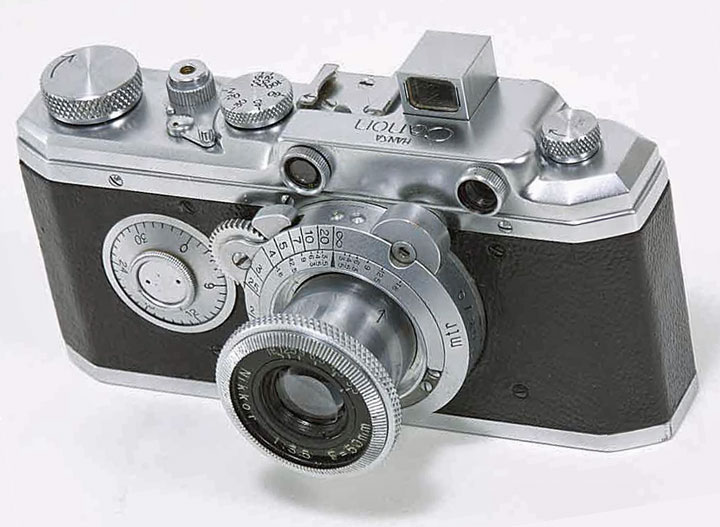
An early Hansa Canon manufactured in late 1935
The Hansa Canon Camera
The Home Page of canonrangefinder.org described how Goro Yoshida, an engineer, in November 1933 with his brother-in-law Saburo Uchida (1899-1982) and with Takeo Maeda (1909-1977), established Seiki-Kōgaku Kenkyusho (Precision Optical Instruments Laboratory).
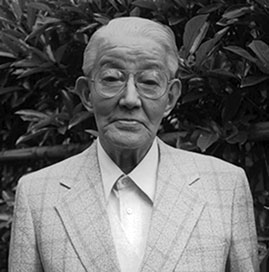
Goro Yoshida in later years
Their intention was to developed a 35mm rangefinder camera. They produced a prototype 35mm camera called the "Kwanon", but which was not commercialized.
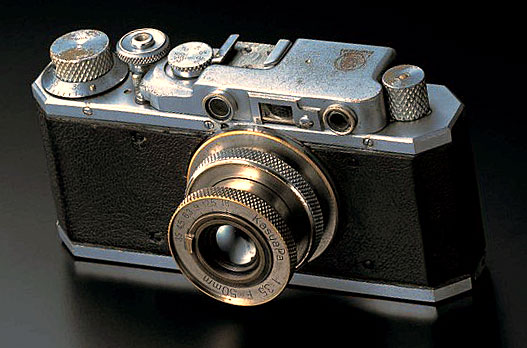
a replica of what the Kwanon camera is thought to have looked like circa 1933
From the "Kwanon" initial designs, Saburo Uchida with Takeo Maeda in 1934 and 1935 20 developed the camera which, with the suggestion of outside investors, became known as "Canon". After being equipped with a lens and lens mount described below, this first Canon camera was first produced in October 1935 and introduced to the Japanese market in February 1936. 1
The Hansa Canon - or Canon Hansa
This first camera with the name "Canon", developed in 1935 and introduced in Japan in early 1936 had the name "Hansa" on its top plate. It is generally referred to today as the "Hansa Canon" or sometimes the "Canon Hansa". I prefer the name "Hansa Canon" as being more descriptive.
Seiki-Kōgaku did not yet have camera sales ability. However, they had a contract with Omiya Shashin Yohin Co., Ltd. (Omiya camera and accessory shop) (大宮フォトサプライ). The owner of Omiya, Hikotara Noro had been one of those instrumental in changing the camera name from "Kwanon" to "Canon". Omiya Shashin Yohin Co., Ltd. used the marketing name "Hansa", and their Hansa trade name was engraved on the top of the camera.

A small number of these cameras were sold directly by Canon to photographers and the press, and do not have the "Hansa" logo on the top.
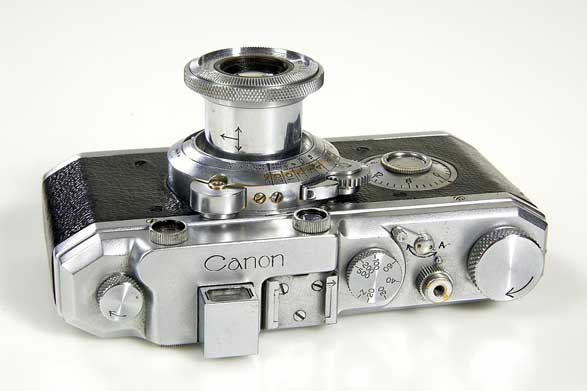
The "Hansa Canon" but without the "Hansa" logo circa 1937
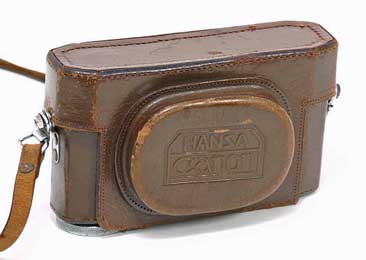
The first Hansa Canon cameras produced in late 1935 used some components from the initial "Kwanon" prototype development cameras. The earliest Hansa Canon models had a depressed area around the pop-up viewfinder as did the Kwanon. The depressed area in fact was no longer needed, since the viewfinder was elevated by pressing a release button on the camera rear, rather than the photographer pulling the viewfinder up.
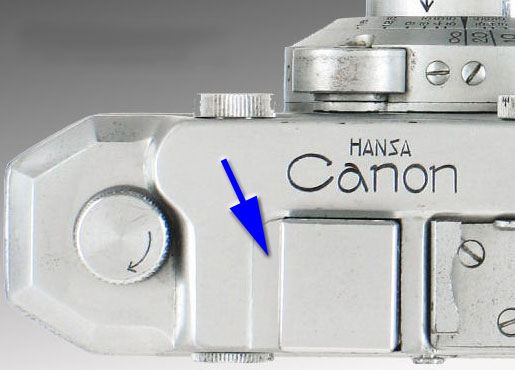
Another feature of the Hansa Canon inherited from the earier Kwanon model was the accessory shoe having semi-circular cut-outs in the accessory shoe retention bracket.
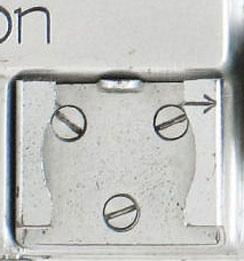
Each Hansa Canon had a lens focusing mount manufactured by Nippon Kōgaku, then the (only) Japanese manufacturer of camera glass and the producer of Nikkor branded lenses. This focusing mount design avoided the Leica focusing patent which had been issued in Japan 1. Under this patent, each Leica lens was fitted with its own helicoid focusing mount, which the photographer turned to focus the lens. The lens assembly then screwed directly into the Leica camera body. The Nikkor focusing mount avoided the Leica patent because focusing was done by the mount rather than by the lens itself.
Each Nikkor focusing mount had a number engraved on its base. Initially, this was engraved with the number and "Nippon Kogaku Tokyo" as shown in the upper photo below. Peter Dechert wrote 19:
"New financing [of Canon] in the summer of 1937 appeared likely to enable Seiki Kogaku to assert their independence. The only immediately apparent result of the infusion of money and new spirit into Seiki Kogaku was that the Nippon Kogaku name disappeared from the Canon Camera. Thus, those cameras that carry 'Nippon Kogaku Tokyo' engraved on the lower part of their focusing mounts are the ones made [before summer 1937]."
The lower photo below shows the focusing mount with engraved serial number, but without the Nippon Kogaku identification. This was the focusing mount style used on the later Hansa Canon, and on the later Canon S and Canon NS.
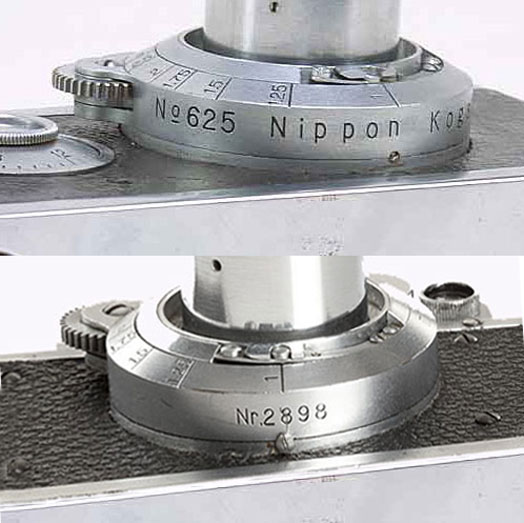
These focusing mount numbers are the best way to identify individual Hansa Canon cameras. However, there was also a serial number stamped inside the base plate of each camera.
Peter Dechert 1 stated:
"Lensmount serial numbers are in fact the only way to individualize Canon Hansa cameras, which were assembled roughly in lensmount number sequence until 1939. Numbers stamped on the inside of the baseplates are design types, 1xxx had the central socket, while 2xxx and 3xxx had a socket at the camera's take up end."
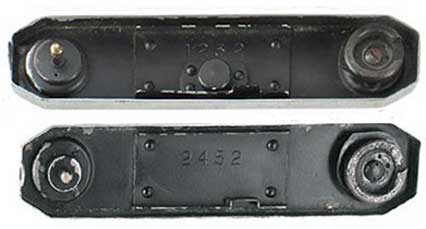
Hansa Canon base plates 1262 and 2452
Hansa Canon Camera Lenses
The Hansa Canon in fact could not have been introduced without sourcing a camera lens, which Seiki-Kōgaku did not produce. The Canon rangefinder needed lenses for the 35mm format, and Nippon Kōgaku was able to fulfill that need by developing a new lens. This was a new Nikkor 5cm f3.5 lens. Nippon Kōgaku produced the lens for Canon, as well as producing the focusing mount for the lens. Canon fitted the Nikkor 5cm f3.5 lens into a lens mounting tube or flange for insertion into the Nikkor focusing mount. Interestingly, the focusing mount with its locking mechanism in the Nikkor design closely resembled the design of the German Contax camera lens mount.
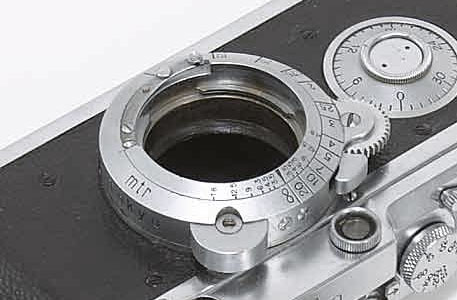
The optical company Nippon Kōgaku Kogyo - 日本光学工業株式会社 or "Japan Optical Industries Co., Ltd." had been created in 1917 23 during World War I, aided by the Imperial Japanese Navy and the Mitsubishi group. 20 Nippon Kōgaku were not yet making cameras themselves. The later famous series of 'Nikon' cameras was launched in 1948. From Canon's beginning, Nippon Kōgaku Kogyo provided the lenses for all Canon cameras until Canon's own lens production began in 1946-1947. 2
Nikkor 50mm f3.5 lens
The first lenses supplied for the Hansa Canon were te Nikkor 50mm f3.5 lens, in a black face.
Initially, the Nikkor 50mm f3.5 lenses were supplied to Seiki-Kōgaku in metal tubes to which Seiki-Kōgaku would add the appropriate lens mounting flange for mounting into the camera. Early versions of these Nikkor lenses had f-stops selected on the lens front. In 1936, the marked f-stop progression was the earlier progression then in use: f3.5, f4.5, f6.3, f9, f12.5, f18.
These Nikkor lenses came first in black faces, which during 1936 and 1937 production did not have lens serial numbers on the lens bodies. In 1937, Nippon Kōgaku Kogyo produced and improved lens, now labeled as "5cm" - the 5cm f3.5 lens, which they manufactured with a white face. Also for the first time, lens serial numbers were engraved on the lens face.

1936 or 1937 Hansa Canon black face Nikkor 5cm f3.5 lens without lens serial number

1937 Hansa Canon white face Nikkor 5cm f3.5 lens serial number 50559
Nikkor 5cm f2.0 lens
A small number of Hansa Canons, perhaps, and certainly Canon S bodies were fitted with a Nikkor 5cm f2.0 lens. Initially this was f-stops set internally in a black ring with f-stops of f2, 2.8, 4, 5.6, 8, 11, 16 and 22. Later, this was updated to f-stops set by an external ring up to f16 in a silver constructions. This Nikkor 5cm f2.0 lens may have continued in small numbers during the early WW2 years. This Nikkor 5cm f2.0 was of 6 elements in 2 groups, similar to the Zeiss Sonnar lans. 1
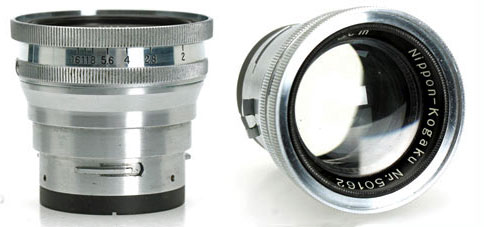
an early Nikkor 5cm f2.0 lens serial number 50162
Nikkor 3.5cm f3.5 lens
During Hansa Canon production, accessory lenses do not seem to have been offered to be used with the camera. However, a Nipon-Kogaku 3.5cm f3.5 lens in a Hansa Canon lens housing has been discovered, now part of the JCII Museum Collection in Tokyo. This is the only accessory lens for the Hansa Canon so far discovered.
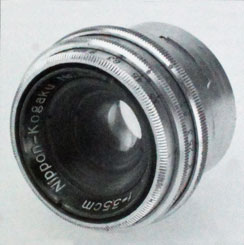
unique Nikkor Nipon-Kogaku 3.5cm f3.5 lens for the Hansa Canon
Introduction of the Hansa Canon
Since Seiki-Kōgaku did not yet have its own camera sales ability, its contract with Omiya Shashin Yohin Co., Ltd. (Omiya camera and accessory shop) (大宮フォトサプライ), described above, was essential.
Omiya launched the Hansa Canon in February 1936. 1 Peter Dechert described the early days of the Hansa Canon commercialization:
"Although the Hansa Canon was originally advertised in October 1935, very few were available for purchase. Operating from their initial small workship in the Ripoongi area of Tokyo, Seiki Kogaku's assemblers and finishers were still learning the art of putting a precision camera together. Not until June 1936 was a larger facility in the Meguroku area acquired in order to 'produce large quantities' of the Canon camera." 1
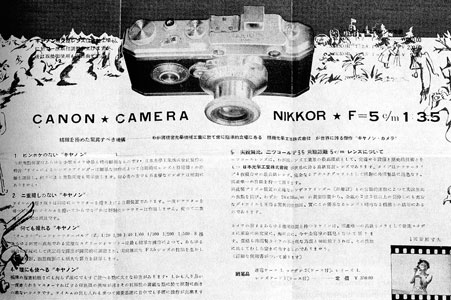
a 1935 advertisement featuring "Canon Camera" and "Nikkor f 5cm 1:3.5"
As well as selling via Omiya, Seiki-Kōgaku also sold some of these Canons, without the Hansa logo, directly to photographers. Dechert states that the sales of the camera without the 'Hansa' logo was only about one-quarter the quantity of Hansa Canon sales 1.
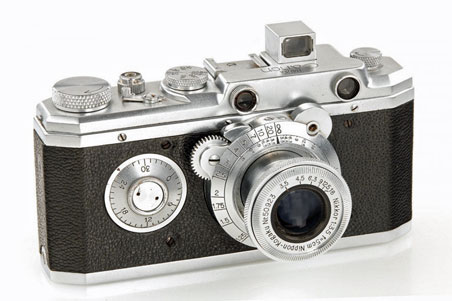
Hansa Canon mount 1287 with chrome 5cm f3.5 lens
The Importance of the Hansa Canon
The successful introduction of the Hansa Canon was the basis of a small and slowly growing company which was eventually to grow into the massive Canon Camera Company and eventually Canon, Inc. Its success allowed Canon designers to develop and introduce the "Canon S" which initially was referred to as the "Canon Newest Model". This new camera was introducted in late 1938. You may read about this interesting camera, which added slow shutter speeds and other features by clicking on this link to the Canon S camera.
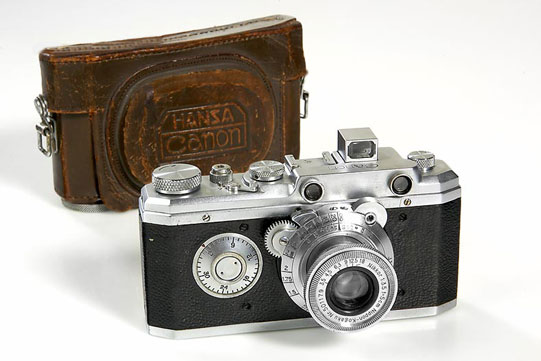
the classic Hansa Canon
You can click on the links in the table below to consult other pages of the canonrangfinder.org site.
| Navigation: Click Below to Jump to Desired Subject Page | ||
|---|---|---|
| Canon Rangefinder Cameras - 1 | Canon Rangefinder Cameras - 2 | Canon Rangefinder Lenses |
| Canon Hansa | Canon IIAF, IIAX | Development Nikkor 50mm |
| Canon S | Canon IVSB2 | Canon 19mm |
| Canon J | Canon IIS2, IID2, IIF2 | Canon 25mm |
| Canon NS | Canon VT, Canon L2 | Canon 28mm |
| Canon JS | Canon L1, L3 | Canon 35mm |
| Canon S-I | Canon VT Deluxe | Canon 50mm |
| Canon J-II | Canon VL, VL2 | Canon 85mm |
| Canon S-II | Canon VI-L, VI-T | Canon 100mm |
| Canon IIB | Canon P | Canon 135mm |
| Canon III, IIC, IV | Canon 7 | Canon 200mm-1000mm |
| Canon IIIA, IVF, IVS | Canon 7s | Canon Accessories |
| Canon IIA, IID, IID1 | Nicca Rangefinders | Canon Finders |
| Canon IVSB | Leotax Rangefinders | Minolta Rangefinders |
| Canon IIF, IIS | Other Rangefinders | Minolta Lenses |
| Comparison Canon - Nikon Rangefinders | other M39 lenses | |
| Go to canonrangefinder.com home page | ||
Any additions or corrections to these pages would be welcome simply by contacting this site as shown at the foot of this page .
Footnotes:
1 Dechert, Peter. Canon Rangefinder Cameras 1933-1968. Hove Collectors Books. West Sussex, United Kingdom. 1985. ISBN 0-906447-30-5.
Peter Dechert's book is the most important expert source of information regarding Canon Rangefinder Cameras.
2 Kitchingman, Peter. Canon M39 Rangefinder Lenses 1939-1971. A Collector's Guide. Published by Peter Kitchingman. Perth, Australia. 2008. ISBN 978-0-646-48144-9.
Peter Kitchingman's book is the definitive study of the more than three decades of M39 format camera lenses developed for Canon Rangefinder Cameras.
3 Nostalgic Canon Camera Book. 懐かしいキヤノン EI Publishing Co. Ltd. Tokyo, Japan. June 2003.
Peter Kitchingman's book is the definitive study of the more than three decades of M39 format camera lenses developed for Canon Rangefinder Cameras.
4 "Canon Camera Museum" history website. https://global.canon/en/c-museum/history/ published by Canon, Inc. accessed in 2019.
5 Rajner, Hans P. (author), John Wade (editor). Leica Copies. Classic Collections Publications. London, UK. ISBN 13: 9781874485056
Hans P. Rajner's book is an excellently detailed and carefully researched study of camera from around the world which used the Leica M39 lens mount and the same lens to film plane distance.
7 Dechert, Peter. Canon Single Lens Reflex Cameras 1959-1991. Historical Camera Publications. Yakima, Washington. 1992. ISBN 1-879561-04-2.
8 Tomlinson, Shawn M. The Film Photography Book. Lulu Pulbications. 2016. ISBN: 9781365263972
9 Sartorius, Ghester. Identifying Leica Lenses. Classic Camera 19. Tokyo, Japan. 2001. ISBN 4-257-12029-0
10 website http://www.nicovandijk.net/rflensmatrix.htm consulted 2019.
11 O'Reagan, Douglas M. Allied Exploitation of German Science after World War II. Johns Hopkins University Press. Baltimore, Maryland. 2019. ISBN 9781421428888
12 website www.canonrangefinder.servehttp.com consulted 2008.
13 Minolta expert Andrea Aprà has posted information on minoltarangefinders group and other groups and further detailed information by email. (thanks Andrea !)
14 website http://www.collection-appareils.fr/objectifs/ consulted 2019.
15 Small, Marc James. Non-Leitz Leica Thread-Mount Lenses. Wittig Books. Hückelhoven, Germany. 1997. ISBN 3-930359-47-2.
16 the Nikon Corporation website: https://imaging.nikon.com/history/ consulted 2019.
17 p 152. Ray, Sidney F. Photographic Lens ISBN 9780240510323
18 website http://www.rokkorfiles.com/Lens%20History.html accessed 2019
19 p. 10. Dechert, Peter. The Contax Connection. The History of the Japanese Camers. Historical Camera Publications. 1 August 1990.
If you have any comments or questions about this Canon Rangefinder site, please e-mail me (Larry Huffman) at e-mail address: [email protected]